22nd AUGUST 1907 BHIKAJI RUSTOM CAMA DESIGNED INDIAN NATIONAL FLAG
The Indian National Flag symbolises national pride and is one of the most respectable national symbols. The late Prime MinisterJawaharlal Nehru called it "a flag not only of freedom for ourselves, but a symbol of freedom to all people."
As per the Indian laws, the national flag is to be made up of khadi. The Flag Code of India governs the usage of the flag. Initially the use of flag by private citizens was prohibited except on national days like Republic Day and Independence Day. But gradually some changes were made by the Union Cabinet about the usage of flag by private citizens. The code was amended about its usage for hoisting and its adaptation on other types of clothes.
The Indian national flag is popularly known as Tiranga which means "three colours". It is a horizontal tricolour in equal proportion of deep saffron at the top, white in the middle and green at the bottom. The ratio of the width to the length of the flag is 2:3. At the center of the white band, is a wheel with 24 spokes in navy blue colour that indicates the Dharma Chakra (the wheel of law).
Saffron: Saffron is the upper most colour of the flag and is a symbol of courage and selflessness.
White: The white colour in the Tiranga represents honesty, peace and purity. It highlights the importance of maintaining peace in the country.
Green: The green colour of the flag represents faith and chivalry. It is a symbolism of prosperity, vibrance and life.
Ashoka Chakra: The Ashoka Chakra or the Dharma Chakra (Wheel of Law) has 24 spokes and appears on the number of edicts of Ashoka.
The Indian national flag represents India's long struggle for freedom and is a national treasure. It signifies the status of India as an independent republic. The flag came into being in its present form at the meeting of Constitutional Assembly on 22 July 1947. Since then it has served as the National Flag of the Dominion of India from 15 August 1947 to 26 January 1950 and, thereafter, as the national flag of the Republic of India. The Indian National Flag was designed by Pingali Venkayya and contains three equal strips of saffron, white and green.
1904-06:: The history of the Indian flag dates back to pre-independence era. It was during 1904-06 that the first Indian flag came into being. It was made by an Irish disciple of Swami Vivekananda. Her name was Sister Nivedita and after some time this flag came to be known as Sister Nivedita's flag. This flag was coloured red and yellow. Red signified the freedom struggle and yellow was a symbol of victory. It had the words "Bonde Matoram" in Bengali written on it. Along with it the flag contained a figure of 'Vajra', weapon of god 'Indra', and a white lotus in the middle. The 'Vajra' is a symbol of strength and lotus depicts purity.
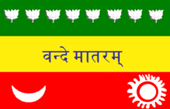 1906: After Sister Nivedita's flag, another flag was designed in 1906. It was a tricolour flag with three equal strips of blue (top), yellow (middle) and red (lower). In this flag the blue strip had eight stars of slightly different shapes. The red strip had two symbols, one of sun and the other of a star and a crescent. The yellow strip had 'Vande Mataram' written on it in Devnagiri script.
1906: After Sister Nivedita's flag, another flag was designed in 1906. It was a tricolour flag with three equal strips of blue (top), yellow (middle) and red (lower). In this flag the blue strip had eight stars of slightly different shapes. The red strip had two symbols, one of sun and the other of a star and a crescent. The yellow strip had 'Vande Mataram' written on it in Devnagiri script.
In the same year another version of this flag was created. It was also tricolour but its colours were different. It had orange, yellow and green and came to be known as 'Calcutta flag' or 'Lotus flag', as it had eight half opened lotuses on it. It is believed to be designed by Sachindra Prasad Bose and Sukumar Mitra. It was unfurled on 7 August 1906 at Parsi Bagan Square, Kolkata. It was a "boycott day" against the partition of Bengal and Sir Surendranath Banerjee hoisted this flag to mark the unity of India.
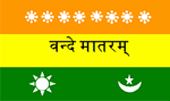 1907:Then came the Madam Bhikaji Rustom Cama's flag. The flag was collectively designed by Madam Bhikaji Cama, Vinayak Damodar Savarkar (Veer Savarkar) and Shyamji Krishna Varma. The flag was unfurled by Madam Cama on 22 August 1907 at Stuttgrat, Germany, and attained the status of the first Indian flag to be hoisted at the foreign land. From this event onwards it was also referred to as 'Berlin Committee flag'. The flag consisted of three colours- the topmost being green followed by golden saffron in the middle and the red colour at the bottom.
1907:Then came the Madam Bhikaji Rustom Cama's flag. The flag was collectively designed by Madam Bhikaji Cama, Vinayak Damodar Savarkar (Veer Savarkar) and Shyamji Krishna Varma. The flag was unfurled by Madam Cama on 22 August 1907 at Stuttgrat, Germany, and attained the status of the first Indian flag to be hoisted at the foreign land. From this event onwards it was also referred to as 'Berlin Committee flag'. The flag consisted of three colours- the topmost being green followed by golden saffron in the middle and the red colour at the bottom.
1916: In 1916 Pingali Venkayya, a writer and a geophysicist designed a flag with the intention to bring the whole nation together. He met Mahatma Gandhi and sought his approval. Mahatma Gandhi suggested him to incorporate a charkha as a symbol of economic regeneration of India, in the flag. Pingali made the flag out of the hand spun yarn 'Khadi'. The flag had two colours and a 'Charkha' drawn across them but Mahatma Gandhi did not approve of it as he said that the red represents the Hindu community and the green represents the Muslims, but all the other communities of India are not represented in this flag.
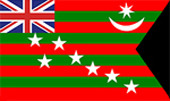 1917:The Home Rule League formed by Bal Gangadhar Tilak adopted a new flag in 1917, as at that time status of Dominion was being demanded for India. The flag had the union jack at the top, near the hoist. The rest of the flag contains five red and four blue strips. It had seven stars on it in the shape of 'Saptarishi' constellation which is supposed to be the sacred one for the Hindus. It also had a crescent moon and a star at the top fly end. This flag did not gain popularity among the masses.
1917:The Home Rule League formed by Bal Gangadhar Tilak adopted a new flag in 1917, as at that time status of Dominion was being demanded for India. The flag had the union jack at the top, near the hoist. The rest of the flag contains five red and four blue strips. It had seven stars on it in the shape of 'Saptarishi' constellation which is supposed to be the sacred one for the Hindus. It also had a crescent moon and a star at the top fly end. This flag did not gain popularity among the masses.
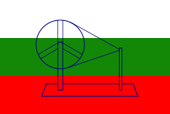 1921: As Mahatma Gandhi wanted all the communities of India to be represented in the flag of the nation, a new flag was designed. This flag had three colours. At the top was white then green and at the bottom was red colour. In this flag the colour white symbolised minority communities of India, green was for the Muslims and the red one was for the Hindu and Sikh communities. The 'Charkha' was drawn across all the bands symbolising the unification of these communities. The pattern of this flag was based on the flag of Ireland, another nation which was struggling to get its independence from the rule of Britain. Although the Congress Committee did not adopted it as its official flag but it was widely used as a symbol of nationality in India's freedom struggle.
1921: As Mahatma Gandhi wanted all the communities of India to be represented in the flag of the nation, a new flag was designed. This flag had three colours. At the top was white then green and at the bottom was red colour. In this flag the colour white symbolised minority communities of India, green was for the Muslims and the red one was for the Hindu and Sikh communities. The 'Charkha' was drawn across all the bands symbolising the unification of these communities. The pattern of this flag was based on the flag of Ireland, another nation which was struggling to get its independence from the rule of Britain. Although the Congress Committee did not adopted it as its official flag but it was widely used as a symbol of nationality in India's freedom struggle.
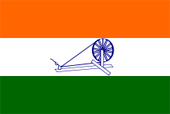 1931: Some people were not at all happy with the communal interpretation of the flag. Keeping all this in view, a new flag was designed which replaced red with ochre. This colour signified combined spirit of both the religions as saffron was the colour of Hindu yogis as well as Muslim darvesh. But the Sikh community also demanded a separate representation in the flag or the complete abandonment of religious colours. This resulted in another flag by Pingali Venkayya. This new flag had three colours. Saffron was at the top followed by white in the middle and green being the lowermost. The 'Charkha' was at the center of white colour. This flag was passed at the meeting of Congress Committee in 1931 and was adopted as the official flag of the Committee.
1931: Some people were not at all happy with the communal interpretation of the flag. Keeping all this in view, a new flag was designed which replaced red with ochre. This colour signified combined spirit of both the religions as saffron was the colour of Hindu yogis as well as Muslim darvesh. But the Sikh community also demanded a separate representation in the flag or the complete abandonment of religious colours. This resulted in another flag by Pingali Venkayya. This new flag had three colours. Saffron was at the top followed by white in the middle and green being the lowermost. The 'Charkha' was at the center of white colour. This flag was passed at the meeting of Congress Committee in 1931 and was adopted as the official flag of the Committee.
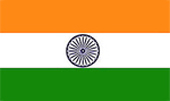 1947: When India got independence, a committee headed by Rajendra Prasad was formed to discuss the National Flag of India and they decided to adopt the flag of Indian National Congress, with suitable modifications, as the flag of India. As a result, the flag of 1931 was adopted as Indian flag but 'Charkha' in the middle was replaced by 'Chakra' (wheel) and hence our National Flag came into being.
1947: When India got independence, a committee headed by Rajendra Prasad was formed to discuss the National Flag of India and they decided to adopt the flag of Indian National Congress, with suitable modifications, as the flag of India. As a result, the flag of 1931 was adopted as Indian flag but 'Charkha' in the middle was replaced by 'Chakra' (wheel) and hence our National Flag came into being.
 British India Flag 1858-1947:This flag introduced by British India in 1858, whose design was based on western heraldic standards, was similar to flags of other British colonies, including Canada and Australia. The blue banner included the Union Flag in the upper-left quadrant and a Star of India capped by the royal crown in the middle of the right half.
British India Flag 1858-1947:This flag introduced by British India in 1858, whose design was based on western heraldic standards, was similar to flags of other British colonies, including Canada and Australia. The blue banner included the Union Flag in the upper-left quadrant and a Star of India capped by the royal crown in the middle of the right half.
WBST100115
EBAKB100115
Last Updated on : August 12, 2015
As per the Indian laws, the national flag is to be made up of khadi. The Flag Code of India governs the usage of the flag. Initially the use of flag by private citizens was prohibited except on national days like Republic Day and Independence Day. But gradually some changes were made by the Union Cabinet about the usage of flag by private citizens. The code was amended about its usage for hoisting and its adaptation on other types of clothes.
The Indian national flag is popularly known as Tiranga which means "three colours". It is a horizontal tricolour in equal proportion of deep saffron at the top, white in the middle and green at the bottom. The ratio of the width to the length of the flag is 2:3. At the center of the white band, is a wheel with 24 spokes in navy blue colour that indicates the Dharma Chakra (the wheel of law).
Blank India Flag for Kids
The colours of the flag have a significance of their own:
Saffron: Saffron is the upper most colour of the flag and is a symbol of courage and selflessness.
White: The white colour in the Tiranga represents honesty, peace and purity. It highlights the importance of maintaining peace in the country.
Green: The green colour of the flag represents faith and chivalry. It is a symbolism of prosperity, vibrance and life.
Ashoka Chakra: The Ashoka Chakra or the Dharma Chakra (Wheel of Law) has 24 spokes and appears on the number of edicts of Ashoka.
History of Indian National Flag
The Indian national flag represents India's long struggle for freedom and is a national treasure. It signifies the status of India as an independent republic. The flag came into being in its present form at the meeting of Constitutional Assembly on 22 July 1947. Since then it has served as the National Flag of the Dominion of India from 15 August 1947 to 26 January 1950 and, thereafter, as the national flag of the Republic of India. The Indian National Flag was designed by Pingali Venkayya and contains three equal strips of saffron, white and green.
The history of the Indian National Flag over the years:
1904-06:: The history of the Indian flag dates back to pre-independence era. It was during 1904-06 that the first Indian flag came into being. It was made by an Irish disciple of Swami Vivekananda. Her name was Sister Nivedita and after some time this flag came to be known as Sister Nivedita's flag. This flag was coloured red and yellow. Red signified the freedom struggle and yellow was a symbol of victory. It had the words "Bonde Matoram" in Bengali written on it. Along with it the flag contained a figure of 'Vajra', weapon of god 'Indra', and a white lotus in the middle. The 'Vajra' is a symbol of strength and lotus depicts purity.
 1906: After Sister Nivedita's flag, another flag was designed in 1906. It was a tricolour flag with three equal strips of blue (top), yellow (middle) and red (lower). In this flag the blue strip had eight stars of slightly different shapes. The red strip had two symbols, one of sun and the other of a star and a crescent. The yellow strip had 'Vande Mataram' written on it in Devnagiri script.
1906: After Sister Nivedita's flag, another flag was designed in 1906. It was a tricolour flag with three equal strips of blue (top), yellow (middle) and red (lower). In this flag the blue strip had eight stars of slightly different shapes. The red strip had two symbols, one of sun and the other of a star and a crescent. The yellow strip had 'Vande Mataram' written on it in Devnagiri script. In the same year another version of this flag was created. It was also tricolour but its colours were different. It had orange, yellow and green and came to be known as 'Calcutta flag' or 'Lotus flag', as it had eight half opened lotuses on it. It is believed to be designed by Sachindra Prasad Bose and Sukumar Mitra. It was unfurled on 7 August 1906 at Parsi Bagan Square, Kolkata. It was a "boycott day" against the partition of Bengal and Sir Surendranath Banerjee hoisted this flag to mark the unity of India.
 1907:Then came the Madam Bhikaji Rustom Cama's flag. The flag was collectively designed by Madam Bhikaji Cama, Vinayak Damodar Savarkar (Veer Savarkar) and Shyamji Krishna Varma. The flag was unfurled by Madam Cama on 22 August 1907 at Stuttgrat, Germany, and attained the status of the first Indian flag to be hoisted at the foreign land. From this event onwards it was also referred to as 'Berlin Committee flag'. The flag consisted of three colours- the topmost being green followed by golden saffron in the middle and the red colour at the bottom.
1907:Then came the Madam Bhikaji Rustom Cama's flag. The flag was collectively designed by Madam Bhikaji Cama, Vinayak Damodar Savarkar (Veer Savarkar) and Shyamji Krishna Varma. The flag was unfurled by Madam Cama on 22 August 1907 at Stuttgrat, Germany, and attained the status of the first Indian flag to be hoisted at the foreign land. From this event onwards it was also referred to as 'Berlin Committee flag'. The flag consisted of three colours- the topmost being green followed by golden saffron in the middle and the red colour at the bottom.1916: In 1916 Pingali Venkayya, a writer and a geophysicist designed a flag with the intention to bring the whole nation together. He met Mahatma Gandhi and sought his approval. Mahatma Gandhi suggested him to incorporate a charkha as a symbol of economic regeneration of India, in the flag. Pingali made the flag out of the hand spun yarn 'Khadi'. The flag had two colours and a 'Charkha' drawn across them but Mahatma Gandhi did not approve of it as he said that the red represents the Hindu community and the green represents the Muslims, but all the other communities of India are not represented in this flag.
 1917:The Home Rule League formed by Bal Gangadhar Tilak adopted a new flag in 1917, as at that time status of Dominion was being demanded for India. The flag had the union jack at the top, near the hoist. The rest of the flag contains five red and four blue strips. It had seven stars on it in the shape of 'Saptarishi' constellation which is supposed to be the sacred one for the Hindus. It also had a crescent moon and a star at the top fly end. This flag did not gain popularity among the masses.
1917:The Home Rule League formed by Bal Gangadhar Tilak adopted a new flag in 1917, as at that time status of Dominion was being demanded for India. The flag had the union jack at the top, near the hoist. The rest of the flag contains five red and four blue strips. It had seven stars on it in the shape of 'Saptarishi' constellation which is supposed to be the sacred one for the Hindus. It also had a crescent moon and a star at the top fly end. This flag did not gain popularity among the masses. 1921: As Mahatma Gandhi wanted all the communities of India to be represented in the flag of the nation, a new flag was designed. This flag had three colours. At the top was white then green and at the bottom was red colour. In this flag the colour white symbolised minority communities of India, green was for the Muslims and the red one was for the Hindu and Sikh communities. The 'Charkha' was drawn across all the bands symbolising the unification of these communities. The pattern of this flag was based on the flag of Ireland, another nation which was struggling to get its independence from the rule of Britain. Although the Congress Committee did not adopted it as its official flag but it was widely used as a symbol of nationality in India's freedom struggle.
1921: As Mahatma Gandhi wanted all the communities of India to be represented in the flag of the nation, a new flag was designed. This flag had three colours. At the top was white then green and at the bottom was red colour. In this flag the colour white symbolised minority communities of India, green was for the Muslims and the red one was for the Hindu and Sikh communities. The 'Charkha' was drawn across all the bands symbolising the unification of these communities. The pattern of this flag was based on the flag of Ireland, another nation which was struggling to get its independence from the rule of Britain. Although the Congress Committee did not adopted it as its official flag but it was widely used as a symbol of nationality in India's freedom struggle. 1931: Some people were not at all happy with the communal interpretation of the flag. Keeping all this in view, a new flag was designed which replaced red with ochre. This colour signified combined spirit of both the religions as saffron was the colour of Hindu yogis as well as Muslim darvesh. But the Sikh community also demanded a separate representation in the flag or the complete abandonment of religious colours. This resulted in another flag by Pingali Venkayya. This new flag had three colours. Saffron was at the top followed by white in the middle and green being the lowermost. The 'Charkha' was at the center of white colour. This flag was passed at the meeting of Congress Committee in 1931 and was adopted as the official flag of the Committee.
1931: Some people were not at all happy with the communal interpretation of the flag. Keeping all this in view, a new flag was designed which replaced red with ochre. This colour signified combined spirit of both the religions as saffron was the colour of Hindu yogis as well as Muslim darvesh. But the Sikh community also demanded a separate representation in the flag or the complete abandonment of religious colours. This resulted in another flag by Pingali Venkayya. This new flag had three colours. Saffron was at the top followed by white in the middle and green being the lowermost. The 'Charkha' was at the center of white colour. This flag was passed at the meeting of Congress Committee in 1931 and was adopted as the official flag of the Committee. 1947: When India got independence, a committee headed by Rajendra Prasad was formed to discuss the National Flag of India and they decided to adopt the flag of Indian National Congress, with suitable modifications, as the flag of India. As a result, the flag of 1931 was adopted as Indian flag but 'Charkha' in the middle was replaced by 'Chakra' (wheel) and hence our National Flag came into being.
1947: When India got independence, a committee headed by Rajendra Prasad was formed to discuss the National Flag of India and they decided to adopt the flag of Indian National Congress, with suitable modifications, as the flag of India. As a result, the flag of 1931 was adopted as Indian flag but 'Charkha' in the middle was replaced by 'Chakra' (wheel) and hence our National Flag came into being.  British India Flag 1858-1947:This flag introduced by British India in 1858, whose design was based on western heraldic standards, was similar to flags of other British colonies, including Canada and Australia. The blue banner included the Union Flag in the upper-left quadrant and a Star of India capped by the royal crown in the middle of the right half.
British India Flag 1858-1947:This flag introduced by British India in 1858, whose design was based on western heraldic standards, was similar to flags of other British colonies, including Canada and Australia. The blue banner included the Union Flag in the upper-left quadrant and a Star of India capped by the royal crown in the middle of the right half.Manufacturing
: The 'Bureaue of Indian Standards (BIS)' sets standards for the manufacturing of the flag. It specifies the cloth, dye, colour, thread count and each and every thing about the flag, besides laying out rules regarding its hoisting. The Indian flag can only be made up of 'Khadi'. It is made up of two types of khadi one for its main part and the other one for the cloth which holds flag to the staff.Code of Conduct
Being a national symbol it is respected by every Indian. There are certain dos and don'ts laid down for common people regarding the Indian flag:- When the National Flag is raised the saffron colour band should be at the top.
- No flag or emblem should be placed either above the National Flag or to its right.
- All other flags to be placed to the left of the National Flag if they are hung in a line.
- When the National Flag is carried out in a procession or parade, it shall be on the marching right or in front of the center of the line, if there is a line of other flags.
- Normally the National Flag should be flown over important government buildings like the Rashtrapati Bhawan, the Parliament House, the Supreme Court of India, the High Courts, the Secretariats, the Commissioners' office etc.
- The National Flag or any imitation of it must not be used for purpose of trade, business, or profession.
- The National Flag should always be taken down in the evening at sunset.
Some Interesting Facts
- Designed by: Pingali Venkayya
- Adopted: 22 July 1947
- The Indian flag was hoisted on the highest mountain peak of the world, Mount Everest on 29 May 1953.
- Madam Bhikaji Rustom Cama was the first person to hoist Indian flag on foreign soil on 22 August 1907 in Stuttgrat, Germany.
- The Indian National Flag flew to space in 1984 when Wing Commander Rakesh Sharma went to the space. The flag was attached as a medallion on the space suit of Rakesh Sharma.
- The National Flag hoisted at Central Park, Connaught Place, New Delhi is one of the largest in India. It is 90 feet in length, 60 feet in width and is hoisted on a flagpole of 207 feet.
- India holds a world record of forming largest human flag which was formed by 50,000 volunteers in Chennai in December 2014.
WBST100115
EBAKB100115
Last Updated on : August 12, 2015
Last Updated on : August 12, 2015
Culture & Religion of India
Bhikaji Cama: A Biography
| . | |||||||||||||||||||||||||||||||||||||||||||||||||||||||
Search ResultsBhikaiji Cama - Wikipedia, the free encyclopedia
https://en.wikipedia.org/wiki/Bhikaiji_Cama
Madame Bhikaji Cama ... On 22 August 1907, Cama attended the International Socialist Conference in Stuttgart, Germany, where ... Cama's flag, a modification of the Calcutta Flag, was co-designed by Cama, Vinayak Damodar ... later serve as one of the templates from which the current national flag of India was created.India Flag, History of Indian Flag - Maps of India
www.mapsofindia.com/maps/india/national-flag.htm
As per the Indian laws, the national flag is to be made up of khadi. The Flag Code of ... 1907:Then came the Madam Bhikaji Rustom Cama's flag. The flag was ...Biography of Madam Bhikaji Cama - Kamat's Potpourri
www.kamat.com › Timeless Theater › Biographies
Jun 24, 2015 - It has been made sacred by the blood of young Indians who sacrificed their lives. I call upon you, gentlemen to rise and salute this flag of Indian ... The year was 1907 and the time, 3rd week of August. ... It was hence, no mean achievement of Madam Cama, when she unfurled the first National Flag at the ...The National Flag of India - TheHolidaySpot
www.theholidayspot.com/indian_independence_day/flag.htm
On 22 August 1907, Shyamji Krishna Varma, Madam Bhikaji Cama and Veer Savarkar together had designed a new flag and this flag came to be known as ...Daughter of India : Madam Cama - Hindu Janajagruti Samiti
www.hindujagruti.org › ... › Heroes of Bharatiya War of Independance
Madam Cama, her life and her immense contribution to India's freedom struggle. ... the first National flag of Hindustan was unfurled on 21st August, 1907. ... The parents named their daughter as Bhikaji. ... To avoid any obstacle that could be created by anybody, Madam Cama carried one flag out of England, having hidden it ...Indian National Flag - desibantu
https://desibantu.com/indian-nation-flag
Jan 23, 2014 - The Indian national flag was designed in 1916 by Pingali Venkayya from ... Varma, Madam Bhikaji Cama and Veer Savarkar had designed a new flag. ... In 1907, the flag was hosted in foreign country Germany first time.TRUTHS ABOUT THE TRICOLOUR, The Hindu « ::Welcome ...
ramachandraguha.in/archives/truths-about-the-tricolour.html
This flag was first hoisted by the great freedom fighter Madam Cama at the ... was the work of the Indian National Congress, which was not Madam Cama's party. ... Between 1918 and 1921 Venkayya raised the question of a national flag at every ... 'in his [Venkayya's] designs I saw nothing to stir the nations to its depths'.NATIONAL FLAG OF INDIA – TIRANGA (TRICOLOR ...
www.indianscriptures.com/...s.../national-flag-of-india-tiranga-tricolor-1
Feb 19, 2014 - 1907: In 1907 a Flag with blue, yellow and red colored was designed by Madam Bhikaji Cama, Veer Savarkar and Shyamji Krishna Varma.Madame Bhikaji Cama by V. Sundaram - Boloji.com
www.boloji.com/index.cfm?md=Content&sd=Articles&ArticleID...
Oct 15, 2006 - Madame Cama was born in 1861 to a well-to-do Parsi family in Bombay. ... During 1907 and 1914, Paris became the most important centre of Indian ... tricolorNational Flag of India which she and her friends had designed in ...India: Historical Flags - CRW Flags Inc.
www.crwflags.com/fotw/flags/in-hist.html
Jump to Biography of Madame Cama - A biography of Madame Bhikaji Cama (1861-1936), by Dr. Jyotsna ... In 1907, Madame Cama unfurled the first Indian National Flagin the International Socialist Conference in Stuttgart (Germany). ... The flag wasdesigned by Veer Savarkar with the help of other revolutionaries.
Kharghar, Navi Mumbai, Maharashtra - From your Internet address - Use precise location
|
by Dr. Jyotsna Kamat
Page Last updated on : June 24, 2015
"This flag is of Indian Independence! Behold, it is born! It has been made sacred by the blood of young Indians who sacrificed their lives. I call upon you, gentlemen to rise and salute this flag of Indian Independence. In the name of this flag, I appeal to lovers of freedom all over the world to support this flag." -- B. Cama , Stuttgart, Germany, 1907
 Madame Bhikaji Cama (1861-1936) It was hence, no mean achievement of Madam Cama, when she unfurled the first National Flag at the International Socialist Conference in Stuttgart (Germany) in 1907. A thousand representatives from several countries were attending. An Indian lady in a colorful sari was a rare phenomena in those days and her majestic appearance and brave and clear words made everybody think that she was a Maharani or at least a princess from a native state. She excelled many Maharanis (queens) of her time in her poise and demeanor. She fought for freedom till the last in her own way, and helped innumerable revolutionaries with money and materials across the sea as she has settled down in London/Paris at the beginning of this century. Her life and mission make a fascinating reading, showing the important role she played in the early years of freedom struggle. Madam Cama was born on 24th September, 1861 of rich Parsi parents. Her father was Sorabji Framji Patel, a famous merchant and man of means, had a large family. Parsis by then were in the forefront of business, education, and industry (when permitted by British) and no less in philanthropy. Young Bhikaji received good English education, but from the beginning she was a rebel, and a nationalist. She had good flair to learn languages and became proficient in arguing her country's cause in different circles at a young age. She was married to Rustom K. R. Cama, a rich handsome social worker and lawyer. But ideologically they were poles apart. Mr. Cama adored British, loved their culture and thought they had done a lot of good to India. Madame Bhikaji, now a full fledged nationalist, always believed that British had fleeced India, and practiced worst form of imperialism. She had thousand and one reasons to present how India was kept in abject poverty by the British to help themselves to become the most powerful country in the world of that period. Their marriage proved to incompatible. Madam Cama meanwhile plunged in several social activities. Plague broke out in Bombay Presidency at that time and she was in the forefront of voluntary team which strive to save plague victims. in the end she herself caught the deadly disease, but was save miraculously. She was left very weak and was advised to go to Europe for rest and recuperation. She left in 1902 for London which was to become her home for the rest of life. She served as private secretary to Dadabhai Navaroji, a great Indian leader in the forefront of national movement. she came in contact with several patriots students and European Intellectuals who were sympathetic to Indian cause during this brief period. Later she herself played a dominant part in promoting freedom struggle.  The tricolor-flag Madam Cama unfurled had green, saffron, and red stripes. Red represented strength, saffron victory, and green stood for boldness and enthusiasm. there were eight lotuses representing the eight provinces and flowers represented princely states. "Vande Mataram" in Devanagari adorned central saffron stripe which meant "salutation to Mother India." The sun and the moon indicated Hindu and Muslim faiths. The flag was designed by Veer Savarkar with the help of other revolutionaries. After Stuttgart, Madam went to United States. She traveled a lot and informed Americans about Indians struggling for Independence. She told about British efforts to smother the voice of educated Indians who protested against tyranny and despotism of British who always boasted themselves as "mother of parliamentary democracy" over the world! She could be called "Mother India's first cultural representative to USA." The tricolor-flag Madam Cama unfurled had green, saffron, and red stripes. Red represented strength, saffron victory, and green stood for boldness and enthusiasm. there were eight lotuses representing the eight provinces and flowers represented princely states. "Vande Mataram" in Devanagari adorned central saffron stripe which meant "salutation to Mother India." The sun and the moon indicated Hindu and Muslim faiths. The flag was designed by Veer Savarkar with the help of other revolutionaries. After Stuttgart, Madam went to United States. She traveled a lot and informed Americans about Indians struggling for Independence. She told about British efforts to smother the voice of educated Indians who protested against tyranny and despotism of British who always boasted themselves as "mother of parliamentary democracy" over the world! She could be called "Mother India's first cultural representative to USA."
Her Paris-home became a shelter for world revolutionaries. Even Lenin, the father of Russian revolution visited her house and exchanged views. Savarkar got all encouragement in writing the history of 1st Indian War of Independence from Cama. She helped its printing in Holland as no English publisher came forward to publish it. It was banned book but found its was to India. Smuggled ingeniously with "Don Quixote" covers! She became publisher of "Vande Mataram" a revolutionary magazine and was a distributor as well, an extremely difficult task in the days of British Espionage. Another magazine "Madan's Talwar" was also started in memory of Madanlal Dhingra who had laid down his life for the country. Both the magazines were outlawed in India and England. Madam Cama somehow found ways to send them to Indian revolution going and for self-defense. Madam Cama also fought for the cause of women. Speaking at National Conference at Cairo, Egypt in 1910, she asked, "Where is the other half of Egypt? I see only men who represent half the country!" She stressed the role of women in building a nation. Her attempts to save Savarkar who jumped into the ocean from the ship "Morena" near Marseilles are well known. A few minutes delay saw the famous revolutionary back into chains, a fact which Madam Cama, came to regret for life. When First World War broke out in 1914, Madam Cama took anti-British stand and tried her best to bring in awareness among Indians about the harm brought in by fighting imperialist forces. The British had banned her entry in India being afraid of her revolutionary past and confirmed nationalistic outlook. But the lioness was getting old and 35 years fighting on foreign land and taken its toll. She decided to return to motherland but was very ill. After reaching Bombay, she was hospitalized and died on the 13th of August 1936. A fearless woman, she brought in awareness of Indian struggle for independence in Europe and America and was instrumental in helping several revolutionaries, with finances and publishing.
See Also:
| |||||||||||||||||||||||||||||||||||||||||||||||||||||||

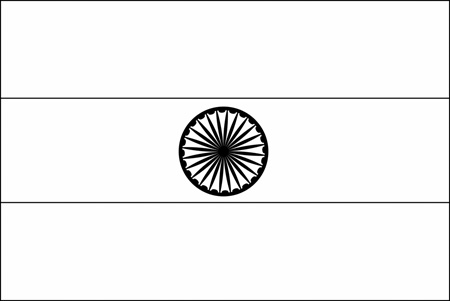
national anthem of india
ReplyDeleteJana Gana Mana is the national anthem of india. It was originally composed as Bharoto Bhagyo Bidhata in Bengali by polymath Rabindranath Tagore. The first stanza of the song Bharoto Bhagyo Bidhata was adopted by the Constituent Assembly of India as the National Anthem on 24 January 1950.
ReplyDelete